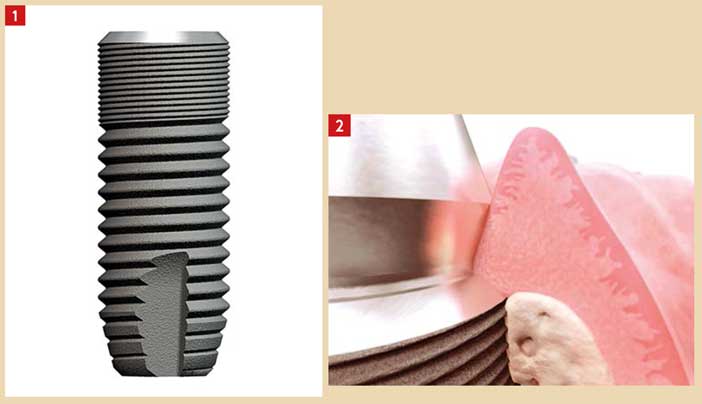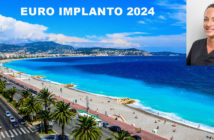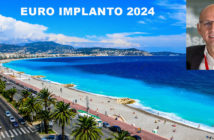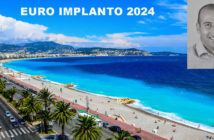L’état de surface implantaire OsseoSpeed™ [1-3]
Lancé en 2004, cet état de surface rugueux (grenaillé) modifie l’ancien état de surface TiOBlast™ par l’adjonction d’ions fluorure dans la couche d’oxyde de titane.
Ces modifications de surface permettent une meilleure interface os/implant [4-7] ainsi qu’une période de cicatrisation plus courte [8, 9]. Cette cicatrisation plus rapide serait attribuée à une amélioration de la différenciation des ostéoblastes [5].
L’absence de col lisse sur cet implant permet d’avoir un état de surface de ce type sur toute la longueur de l’implant.
Macrostructure, les 2 parties du corps de l’implant (Fig. 1)
Si la partie apicale de l’implant est composée de macrospires, sa partie cervicale est en revanche constituée de microspires allant jusqu’au col de l’implant. Ces microspires assurent :
- une augmentation de la surface de contact os/implant [10, 11]
- une meilleure distribution des contraintes à l’os environnant [12, 13] limitant ainsi sa résorption [14-17]
Absence de col lisse – platform-switching, 2 notions indissociables ; influence directe sur les tissus mous (Fig. 2)
Le design de la partie cervicale de l’implant (Connective Contour ™) a une influence directe sur les tissus mous.
Comme précité, cet implant est rugueux sur toute la hauteur de l’implant. Le col lisse horizontal augmente la surface de contact avec les tissus mous [18]. Le platform-switching, quant à lui, augmente aussi la distance entre la surface implantaire et la connexion implant/pilier, limitant ainsi la perte osseuse [19, 20] et augmentant la surface de contact avec les tissus mous autour du pilier prothétique [21].
L’obtention d’un « manchon gingival » épais autour du pilier prothétique permet d’obtenir de bons résultats esthétiques pérennes.

Fig. 1 : les deux parties du corps de l’implant Fig. 2 : absence de col lisse et platform-switching, action sur les tissus mous
Connectique implantaire interne (conical-seal-design)
Il s’agit d’une connexion conique type cône d’emmanchement associée à un dodécagone antirotationnel dans sa partie basse. L’intérêt mécanique majeur inhérent à ce type de connexion est l’absence de micromouvement à la jonction implant/pilier [22-24] limitant ainsi le gap, et ainsi les infiltrations bactériennes dans cette région [25, 26].
Par ailleurs, la rigidité de ce type de connexion limite considérablement les complications sur la vis de pilier (dévissage voire fracture) [22, 23, 27].
Enfin, cette connexion conique associée à la position juxtacrestale de l’implant (la connexion est donc, elle, infra-osseuse) permet une meilleure distribution des contraintes à l’os environnant, limitant ainsi sa résorption [28, 29].
Sur tous ces différents points, ce type de connectique donne de meilleurs résultats que les connexions internes cylindriques [28] ou externes. L’hexagone interne permet quant à lui, un repositionnement facile du pilier prothétique dans la position déterminée au laboratoire de prothèse. Par commodité, des clés de repositionnement du pilier peuvent être utilisées.
Implications cliniques
Maintien de l’os marginal
L’ensemble de ces caractéristiques (état de surface, microspires, connexion conique, platform-switching) permettent un meilleur maintien du niveau de l’os marginal [30, 31]. La perte osseuse moyenne est de 0,24 mm après 5 ans.
Possibilité de faire du 1 temps ou 2 temps chirurgical indépendamment
La position juxta crestale de cet implant permet de réaliser indépendamment des interventions en un ou deux temps chirurgicaux, sans se préoccuper de l’enfouissement de l’implant, celui-ci étant par définition toujours placé en juxta-osseux.
Intérêts lors d’extraction/implantation immédiate et dans les secteurs sous-sinusiens
La présence des microspires permet un ancrage solide dans les derniers « tours de serrage » de l’implant, que ce soit dans une alvéole large sur une faible surface, ou dans le secteur sous-sinusien avec une hauteur osseuse résiduelle faible.
Bibliographie
1. Dohan Ehrenfest, D.M., et al. – Identification card and codification of the chemical and morphological characteristics of 14 dental implant surfaces. J Oral Implantol, 2011. 37(5): p. 525-42.
2. Guo, J., et al. – The effect of hydrofluoric acid treatment of TiO2 grit blasted titanium implants on adherent osteoblast gene expression in vitro and in vivo. Biomaterials, 2007. 28(36): p. 5418-25.
3. Kang, B.S., et al., XPS, AES and SEM analysis of recent dental implants. Acta Biomater, 2009. 5(6): p. 2222-9.
4. Cooper, L.F., et al. – Fluoride modification effects on osteoblast behavior and bone formation at TiO2 grit-blasted c.p. titanium endosseous implants. Biomaterials, 2006. 27(6): p. 926-36.
5. Lamolle, S.F., et al. – The effect of hydrofluoric acid treatment of titanium surface on nanostructural and chemical changes and the growth of MC3T3-E1 cells. Biomaterials, 2009. 30(5): p. 736-42.
6. Meirelles, L., et al. – The effect of chemical and nanotopographical modifications on the early stages of osseointegration. Int J Oral Maxillofac Implants, 2008. 23(4): p. 641-7.
7. Monjo, M., et al. – In vivo expression of osteogenic markers and bone mineral density at the surface of fluoride-modified titanium implants. Biomaterials, 2008. 29(28): p. 3771-80.
8. Berglundh, T., et al. – Bone healing at implants with a fluoride-modified surface: an experimental study in dogs. Clin Oral Implants Res, 2007. 18(2): p. 147-52.
9. Ellingsen, J.E., et al. – Improved retention and bone-tolmplant contact with fluoride-modified titanium implants. Int J Oral Maxillofac Implants, 2004. 19(5): p. 659-66.
10. Hansson, S. and M. Norton, The relation between surface roughness and interfacial shear strength for bone-anchored implants. A mathematical model. J Biomech, 1999. 32(8): p. 829-36.
11. Hansson, S. and M. Werke, The implant thread as a retention element in cortical bone: the effect of thread size and thread profile: a finite element study. J Biomech, 2003. 36(9): p. 1247-58.
12. Hansson, S., The implant neck: smooth or provided with retention elements. A biomechanical approach. Clin Oral Implants Res, 1999. 10(5): p. 394-405.
13. Hudieb, M.I., N. Wakabayashi, and S. Kasugai, Magnitude and direction of mechanical stress at the osseointegrated interface of the microthread implant. J Periodontol, 2010. 82(7): p. 1061-70.
14. Abrahamsson, I. and T. Berglundh, Effects of different implant surfaces and designs on marginal bone-level alterations: a review. Clin Oral Implants Res, 2009. 20 Suppl 4: p. 207-15.
15. Lang, N.P. and S. Jepsen, Implant surfaces and design (Working Group 4). Clin Oral Implants Res, 2009. 20 Suppl 4: p. 228-31.
16. Song, D.W., et al., Comparative analysis of peri-implant marginal bone loss based on microthread location: a 1-year prospective study after loading. J Periodontol, 2009. 80(12): p. 1937-44.
17. Shin, S.Y. and D.H. Han, Influence of a microgrooved collar design on soft and hard tissue healing of immediate implantation in fresh extraction sites in dogs. Clin Oral Implants Res, 2010. 21(8): p. 804-14.
18. Moon, I.S., et al., The barrier between the keratinized mucosa and the dental implant. An experimental study in the dog. J Clin Periodontol, 1999. 26(10): p. 658-63.
19. Abrahamsson, I., et al., The peri-implant hard and soft tissues at different implant systems. A comparative study in the dog. Clin Oral Implants Res, 1996. 7(3): p. 212-9.
20. Degidi, M., et al., Equicrestal and subcrestal dental implants: a histologic and histomorphometric evaluation of nine retrieved human implants. J Periodontol, 2011. 82(5): p. 708-15.
21. Welander, M., I. Abrahamsson, and T. Berglundh, The mucosal barrier at implant abutments of different materials. Clin Oral Implants Res, 2008. 19(7): p. 635-41.
22. Norton, M.R., An in vitro evaluation of the strength of a 1-piece and 2-piece conical abutment joint in implant design. Clin Oral Implants Res, 2000. 11(5): p. 458-64.
23. Norton, M.R., In vitro evaluation of the strength of the conical implantto-abutment joint in two commercially available implant systems. J Prosthet Dent, 2000. 83(5): p. 567-71.
24. Zipprich H, W.P., Lauer H-C, Lange B, Micro-movements at the implantabutment interface measurements, causes and consequences. Implantologie, 2007. 15(ID N° 79041): p. 31-45.
25. Harder, S., et al., Molecular leakage at implant-abutment connection—in vitro investigation of tightness of internal conical implant-abutment connections against endotoxin penetration. Clin Oral Investig. 14(4): p. 427-32.
26. Jansen, V.K., G. Conrads, and E.J. Richter, Microbial leakage and marginal fit of the implant-abutment interface. Int J Oral Maxillofac Implants, 1997. 12(4): p. 527-40.
27. Lavrentiadis, G., et al., Changes in abutment screw dimensions after offaxis loading of implant-supported crowns: a pilot study. Implant Dent, 2009. 18(5): p. 447-53.
28. Hansson, S., Implant-abutment interface: biomechanical study of flat top versus conical. Clin Implant Dent Relat Res, 2000. 2(1): p. 33-41.
29. Hansson, S., A conical implant-abutment interface at the level of the marginal bone improves the distribution of stresses in the supporting bone. An axisymmetric finite element analysis. Clin Oral Implants Res, 2003. 14(3): p. 286-93.
30. Laurell, L. and D. Lundgren, Marginal bone level changes at dental implants after 5 years in function: a meta-analysis. Clin Implant Dent Relat Res, 2011. 13(1): p. 19-28.
31. Bilhan, H., et al., Astra Tech, Brånemark, and ITI implants in the rehabilitation of partial edentulism: two-year results. Implant Dent, 2010. 19(5): p. 437-46.





